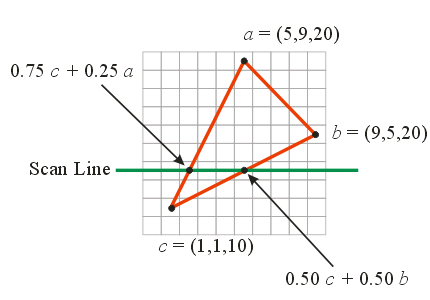-
Answer each of the following:
-
Calculate
\([5 \; 2]^{\perp}\).
-
Convert the point
\([5 \; 2 \; 8 \; 1]^T\)
from homogeneous coordinates to Cartesian coordinates.
-
Convert the point
\([4.0 \; 2.0 \; 1.0 \; 0.5]^T\)
from homogeneous coordinates to Cartesian coordinates.
-
Convert the point
\([-1 \; -7 \; -3]^T\)
from Cartesian coordinates to homogeneous coordinates.
-
Project the 3D (homogeneous) point
\([5 \; 2 \; 8 \; 1]^T\)
onto the plane \(z = 10\) using an orthographic projection.
Note: Do not translate or rotate the point before projectng.
-
Project the 3D (homogeneous) point
\([5 \; 2 \; 8 \; 1]^T\)
onto the plane \(z = 0\) using a perspective projection
with a center of projection at \([0 \; 0 \; -2]^T\).
Note: Do not translate or rotate the point before projectng.
-
Suppose, at a particular point, the light source direction vector
is given (in 3D Cartesian coordinates) by
\(\bs{l} = [1 \; 0 \; 0]^T\) and the
normal direction vector is given by
\(\bs{n} = [0.000 \; 0.707 \; 0.707]^T\).
Compute the reflection vector for a perfectly reflective surface.
Show all of your work.
-
Suppose, at a particular point, the light source direction vector
is given (in 3D Cartesian coordinates) by
\(\bs{l} = [1 \; 0 \; 0]^T\) and the
viewer direction vector is given by
\(\bs{v} = [0 \; 1 \; 0]^T\).
Compute the halfway vector.
Show all of your work.
-
Given a plane defined by the three Cartesian points
\(\bs{a} = [1 \; 0 \; 0]^T\), \(\bs{b} = [0 \; 1 \; 0]^T\),
and \(\bs{c} = [0 \; 0 \; 1]^T\):
-
Find a vector that is perpendicular/orthogonal to this
plane. Show all of your work. Note: Your answer need not
have a norm of 1.
-
Determine whether the
points \(\bs{p} = [10 \; 10 \; 0]^T\) and
\(\bs{q} = [2 \; 0 \; 0]^T\)
lie on the same side of this plane.
Show all of your work.
-
Use the following shear matrix:
\(
\left[ \begin{array}{r r r r}
1.0& 0.5& 0.5& 0.0 \\
0.0& 1.0& 0.0& 0.0 \\
0.5& 0.5& 1.0& 0.0 \\
0.0& 0.0& 0.0& 1.0
\end{array}\right]
\)
to transform the point:
\(
\left[ \begin{array}{r}
10.0 \\
20.0 \\
4.0 \\
1.0
\end{array}\right]
\)
-
Given working versions of the following functions:
getRotationAroundX(double phi)
getRotationAroundY(double theta)
(each of which returns an appropriately sized Matrix),
complete the following trimetricView() function.
/**
* Transforms the given triangle so that it will be rendered using
* a trimetric view. All points are in homogeneous coordinates.
*
* @param phi The rotation around the x axis
* @param theta The rotation around the y axis
* @param p The points
* @return The transformed points
*/
Matrix<4,3> trimetricView(double phi, double theta, Matrix<4,3> p)
{
}
-
In binary space partitioning, when all of the vertices of a
triangle are not on the same side of the plane, we split the
triangle into three pieces. Explain why we split it into three
pieces and not two pieces.
-
Given the following five 2D (Cartesian) points:
\(
\bs{P} =
\left[ \begin{array}{r r r r r}
10 & 7 & 20 & 30 & 1 \\
5 & 7 & 3 & 30 & 15
\end{array}\right]
\)
and the following add() method (in pseudo-code):
add(Point p, Node n)
{
if (p isRightOf n.point)
{
if (n.right == null) n.right = new Node(p)
else add(p, n.right)
}
else
{
if (n.left == null) n.left = new Node(p)
else add(p, n.left)
}
}
draw the binary space partitioning tree that would be generated
by the following "main" method (in pseudo-code):
root = new Node(point[0])
for (i = 1...N-1)
{
add(point[i], root)
}
-
Calculate the \(z\)-value at each relevant pixel
on the scan line in the following triangle.

-
Explain Lambert's Law and how it can be used to model
diffuse reflection.
-
Using the following lighting model:
\(I = 2 \cos \theta\)
and assuming the light source is at the point
\(\bs{s} = [0 \; 10 \; 30 ]^T\) and the normal
vectors at \(\bs{a}\) and
\(\bs{c}\) are given by:
\(\bs{n_a} = [0.577 \; 0.577 \; 0.577 ]^T\)
\(\bs{n_c} = [0.904 \; 0.301 \; 0.301 ]^T\)
calculate the light intensity for all of the relevant pixels on
the scan line in the following triangle line using Gouraud shading.


